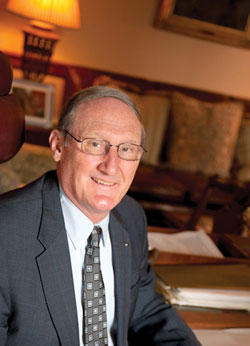A Court and Army Officer: Retired General William Suter Salutes His 20th Year as Clerk

William Suter helps familiarize high court newbies with the procedures. Photo by James Kegley
Ask someone about Elvis Presley and he is likely to recall the 1950s days of “Hound Dog” and “Heartbreak Hotel.” Ask about famed basketball star Elgin Baylor and he may remember cheering for the Los Angeles Lakers.
But ask U.S. Supreme Court Clerk William K. Suter, and he will regale with stories about hanging out with Presley in the army, or going one-on-one against Baylor at an all-star basketball game.
“I made 17 points in that game,” says Suter with a laugh. It was at a 1959 charity game after Suter graduated from San Antonio’s Trinity University, where he played on the college varsity.
As for the King, Presley was at Fort Hood, Texas, in 1958 when Suter was doing Reserve Officers’ Training Corps duty.
“Elvis was training in the next barracks,” says Suter, who has a photo of him and Presley in his office. “He was a good soldier. We all palled around some. They let him live off the post, but he was driven in in the morning with Colonel Parker in the car,” says Suter, referring to Presley’s manager, Tom Parker. “But the soldiers of his company loved him.”
After a career in the U.S. Army, leaving as Acting Judge Advocate General with the rank of major general, and two decades as Supreme Court clerk, Baylor and Elvis are only two of the famous folks that Suter has come to know. Add Colin Powell — with whom Suter served as staff judge advocate in the 101st Airborne Division — and other Defense Department and military leaders, as well as two chief justices, 14 associate justices and a list of renowned appellate lawyers.
That’s a considerable roster, yet Suter calmly focuses on the bottom line: “If you get up every morning and enjoy the work you really have success,” says the 73-year-old Kentucky native.
On February 1 Suter celebrated his 20th year as clerk, the 19th in the court’s history. The clerk manages the court’s docket and calendar and coordinates the compiling of briefs and certiorari petitions, and of organizing the court’s heavy paperwork demands.
As an officer of the court, Suter appears in morning suit when the court is in session and is seated to the left of the bench. He swears in attorneys to the Supreme Court bar, and he and his staff guide newbies facing their first Supreme Court argument through the system, preparing them early and attending to their needs on argument day.
He is the “conduit,” says Suter, among the court, lawyers, litigants, and the public.
“He is the clerk at the court,” says retired Justice Sandra Day O’Connor, who calls herself an enthusiastic fan. “It’s a hard job. He is the court’s interface with the public and with lawyers.”
“He’s an ambassador to the court,” says Supreme Court litigator Tom Goldstein. “He carries himself like a real general. Dealing with other clerk’s offices are sometimes impossible, but his place runs like no other office in the world.”
MISSION-ORIENTED
In addition to the clerk’s regular duties, Suter’s two decades in the office have witnessed a revolution in technology and some of the most controversial decisions the court has delivered.
Take 2000’s Bush v. Gore case. Suter was called in on short notice, but when he got to the courthouse, others had joined him and were pitching in at the clerk’s office.
“I got a call and got back up here wearing blue jeans and a sweat shirt,” Suter says. “But others called and they asked to come up there.”
Goldstein recalls one amusing incident. The case was so rushed that lawyers were meeting in the clerk’s office and there was a knock on the door.
“Someone said, ‘General Suter, we’ve got Geraldo Rivera here and he says you promised him a seat in the clerk’s office,’” Goldstein says. “Along with everything else, that was unusual.”
“People here are mission-oriented,” Suter says. “It’s like the army.”
He says that with pride. Until President George H.W. Bush’s appointed him clerk in 1991, the army was Suter’s home. After graduating from Tulane University Law School, Suter entered the army’s graduate law program at the University of Virginia, beginning a career that would send him all over the world.
His first stop was Alaska, trying felony cases, teaching business law at the University of Alaska — and becoming a ski expert.
His JAG work eventually took him to Thailand and to Vietnam in the early 1970s. With his wife and two sons based in Bangkok, Suter was legal officer stationed at a camp near Saigon. He worked on cases involving assaults, murder and larceny. Many cases involved the sale of drugs. “The [Department of Defense] tried to get kids off drugs,” Suter says. “A lot of them used drugs before they went to Vietnam.”
Combat law practice was daring. “You never knew where combat was,” he says. “If you were out wandering you could catch a round.” A lot of the work required quick travel. “If you wait around two months to try a case, witnesses went back to the states, so you had to work very hard to get witnesses,” Suter says. “All over there were helicopters. They were like taxi cabs. You could pretty easily fly one place or another in a Huey, try a case and be back at night. … They were not your garden variety cases.”
His service in Vietnam earned him a Bronze Star and Distinguished Service Medal. But among the lessons he learned was leadership. “You learn to look up to yourself,” he says.
After returning from Southeast Asia, Suter worked in the Pentagon, and as staff judge advocate of the 101st Airborne Division in Fort Campbell, Ky. From 1980 to 1984 he was commandant at the Judge Advocate General’s School, and later served as chief judge of the U.S. Army Court of Military Review, now called the Court of Criminal Appeals.
As acting Army JAG he was considering retirement in 1990, when a notice for a new clerk at the Supreme Court came up. Just one drawback, Suter says: Being the in the army his entire career he never had to apply outside for a job.
“So I put on my new Nordstrom suit,” he recalls, and was interviewed by Justices O’Connor, Anthony M. Kennedy and Antonin Scalia. Justice O’Connor’s husband, John J. O’Connor — a former Army JAG officer himself — called the next day. Suter was offered the job.
The clerk’s office has a staff of 32 and processes 8,000 cert petitions a year asking. About 2,000 are filed by lawyers, and 6,000 are in forma pauperis. Half of those are pro se. “We make it as easy as we can to get people to file cases here,” Suter says.
Suter makes sure each lawyer understands court procedures. As part of preparation on argument day, he or a staff member accompanies attorneys to the lawyers’ lounge to allow them to prepare. He deals cough drops as needed. “Once you see someone else do it you have a feeling” you can argue, too.
He has witnessed about 1,300 arguments. “There are three secrets to appellate court advocacy,” Suter says. “Preparation, preparation and preparation.”
Among the changes Suter has overseen has been the technological revolution. “It’s a light year of difference” from the paper system, he says.
The docket is electronic and the court web site provides argument transcripts and copies of opinions. “There used to be people who had to come by here and copy a page at 10 cents each,” Suter says. There were three Xerox machines in use all the time, he says. “Now we have one and outsiders use it.”
Suter deals most frequently with the chief justice and the junior justice, who carries over the notes from the justices’ conference. Justice Stephen G. Breyer was doing that job for more than 11 years. “He got good at it,” says Suter.
And although he admires all the justices with whom he has worked, Suter admits his favorite was Justice Lewis F. Powell, who was in retirement when Suter began his job.
“He was the perfect southern gentleman,” says Suter. “He was so unselfish. He joined the army in World War II even though he was not drafted.”
His army rank occasionally slips in when people address him, but Suter does remember the first justice to call him general.
When introduced to Justice Byron R. White, he “shook your hand like it was a football,” says Suter about the justice who once was a professional player. “White grunted, ‘What do I call you?’” Suter recalls White gruffly saying he never worked with a general before. “‘I’ll call you general. You’re a general to me.’”



